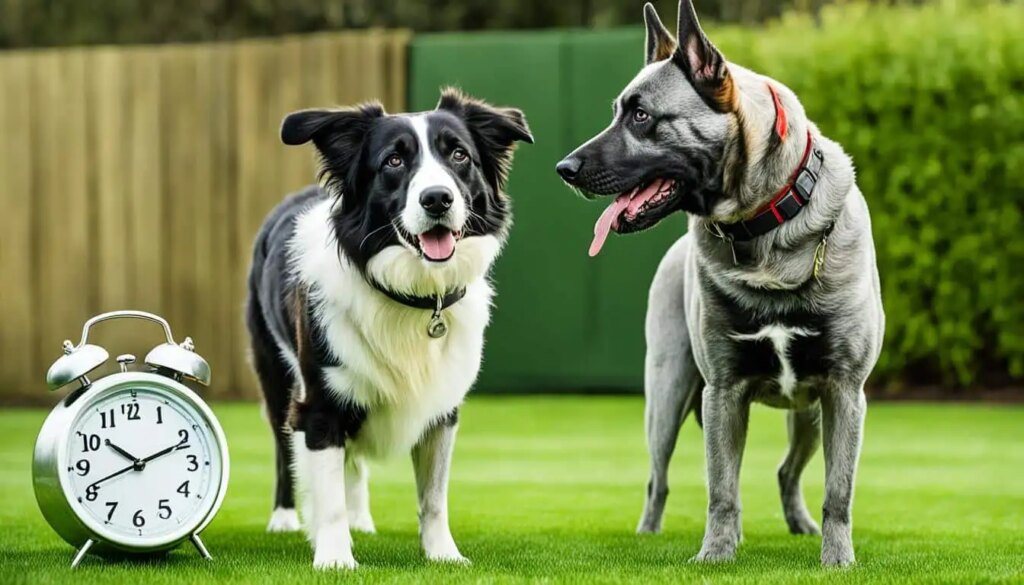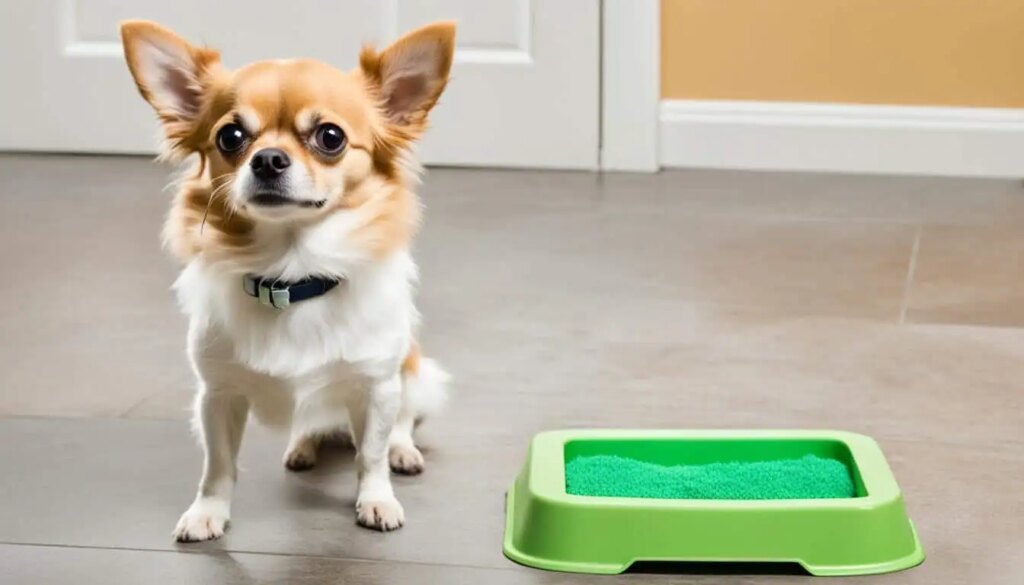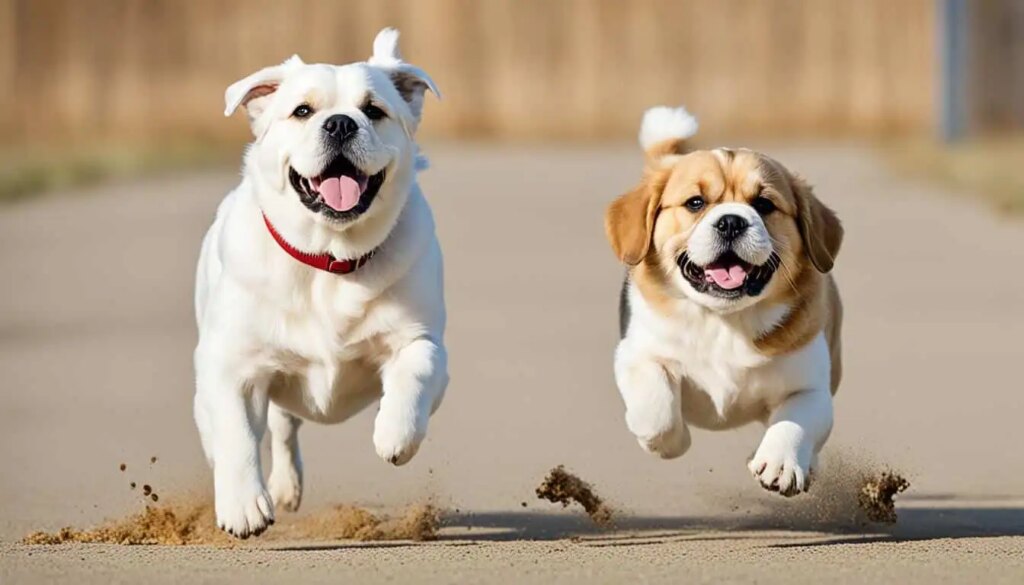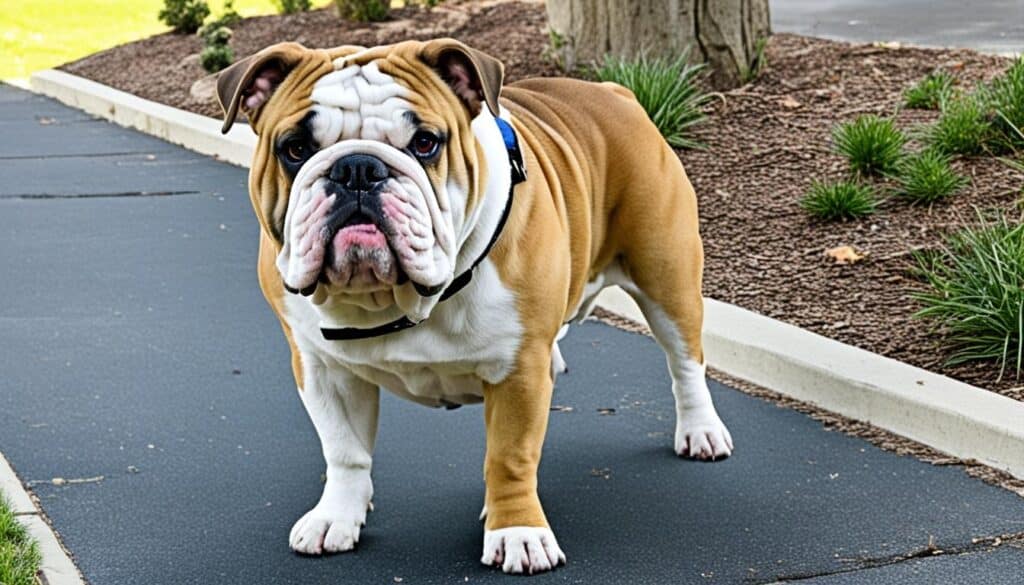Did you know that some dog breeds are significantly more challenging to potty train than others? If you’re struggling with housebreaking difficulties, you’re not alone. In this article, we will explore the hardest dog breeds for potty training challenges and provide valuable insights and tips to help you overcome these struggles effectively.
Key Takeaways:
- Certain dog breeds pose more difficulties for potty training than others
- Factors such as breed characteristics and the dog’s intelligence and stubbornness contribute to housebreaking difficulties
- Patience is crucial in dog training, especially when dealing with challenging breeds
- Understanding the specific challenges of each breed can help you develop targeted strategies for potty training
- Positive reinforcement techniques and establishing a routine play essential roles in successful potty training
Understanding Potty Training Challenges in Dogs
Potty training challenges in dogs can be a frustrating experience for many dog owners. However, by understanding the factors that contribute to housebreaking difficulties, the importance of patience in dog training, and why some breeds struggle more than others, you can better navigate this process.
Factors Contributing to Housebreaking Difficulties
Several factors play a role in making potty training challenging for dogs. These factors include:
- Breed characteristics: Certain breeds may have specific traits or behaviors that make them more prone to potty training struggles.
- Intelligence and stubbornness: The intelligence and stubbornness of a dog can affect their ability to grasp and follow potty training instructions.
- Owner’s patience and consistency: Dogs require consistency and patience from their owners during the potty training process. Lack of these qualities can impede progress.
The Importance of Patience in Dog Training
Patience is a vital virtue when it comes to potty training dogs. It takes time for dogs to learn and develop good potty habits. Rushing the process or becoming frustrated can hinder the dog’s progress and create additional challenges. By maintaining a patient and calm demeanor, you can create a positive and supportive environment for your dog’s potty training journey.
Why Some Breeds Struggle More Than Others
Not all dog breeds are created equal when it comes to potty training. Some breeds inherently struggle more with housebreaking due to their unique traits and behaviors. Certain breeds may be more independent, stubborn, or have higher energy levels, making potty training more challenging. It is crucial to research and understand the specific needs and tendencies of your dog’s breed to tailor your training methods accordingly.
By understanding the factors contributing to potty training challenges, the importance of patience, and why certain breeds may struggle more than others, you can approach the potty training process with a better understanding. This knowledge will help you develop effective strategies and techniques to overcome these challenges and achieve successful potty training for your furry friend.
Which dog breed poses the most challenges for potty training?
When it comes to potty training challenges, certain dog breeds are known to pose more difficulties than others. In this section, we will identify and discuss the dog breed that is considered the most challenging for potty training. By exploring the characteristics and behaviors of this breed, we can understand why it may require extra effort and patience in the housebreaking process. Whether you are considering adopting this breed or already own one, knowing the specific challenges it presents can help you prepare and address these issues effectively.
To help identify the most challenging dog breed for potty training, a comprehensive analysis of various breeds was conducted. Factors such as intelligence, stubbornness, and other behavioral traits were taken into account. The data collected was used to determine which breed presents the greatest difficulties in the housebreaking process.
| Breed | Difficulty for Potty Training |
|---|---|
| Labrador Retriever | Moderate |
| German Shepherd | High |
| Bulldog | Severe |
| Shih Tzu | Extreme |
Based on the analysis, the Shih Tzu breed is regarded as the most challenging for potty training. Shih Tzus are known for their independent nature and can be stubborn when it comes to housebreaking. They require consistent training methods and a patient approach to establish proper potty habits.
The Role of Breed Characteristics in Potty Training
Breed characteristics play a significant role in the ease or difficulty of potty training a dog. Understanding how these characteristics influence potty training can help dog owners tailor their training methods and expectations to accommodate the specific needs of their breed.
How Breed Intelligence Affects Trainability
Breed intelligence is a crucial factor in determining the trainability of a dog. Some breeds are known for their high intelligence and quick learning ability, making them easier to potty train. These breeds can grasp and understand commands more readily, which expedites the housebreaking process.
On the other hand, breeds with lower intelligence may require more repetition and patience in their training. These dogs may take longer to grasp potty training concepts and need consistent reinforcement to establish good habits.
The Effect of Stubbornness on House Training
Stubbornness is another breed characteristic that can impact the housebreaking process. Some breeds are known for their independent nature and strong-willed tendencies, which can make potty training more challenging.
Stubborn breeds may resist following commands or exhibit willful behavior during the potty training process. It is essential for dog owners to demonstrate consistency, patience, and positive reinforcement techniques to overcome stubbornness and establish successful potty training routines.
By considering the breed’s intelligence level and stubbornness, dog owners can better understand the potential difficulties they may encounter during potty training. Adjusting training methods and expectations accordingly can contribute to a more successful and efficient housebreaking process.
Examples of Breed Traits and House Training Difficulty
| Breed | Intelligence | Stubbornness | House Training Difficulty |
|---|---|---|---|
| Border Collie | High | Low | Relatively Easy |
| Bulldog | Low | High | Difficult |
| Golden Retriever | High | Low | Relatively Easy |
| Chihuahua | Low | High | Difficult |
Note: The table above provides examples of breed traits related to intelligence, stubbornness, and the difficulty of house training. Keep in mind that individual dogs may exhibit variations in behavior and trainability, even within a specific breed.
Working vs. Companion Breeds: A Potty Training Comparison
When it comes to potty training, working breeds and companion breeds may present different challenges. Working breeds are typically intelligent and bred for specific purposes, which can contribute to their trainability and adaptability, making them potentially easier to potty train. On the other hand, companion breeds, known for their temperament and close bond with their owners, may require more effort and patience in the housebreaking process.
To better understand the unique challenges that working breeds and companion breeds may face in potty training, let’s compare them:
Working Breeds: These breeds are known for their intelligence and trainability. They are often bred for tasks such as herding livestock, retrieving game, or performing search and rescue. Due to their high level of intelligence, working breeds can learn commands quickly and adapt well to training routines. This intelligence can also extend to potty training, as they are more likely to grasp the concept of where and when to eliminate.
Companion Breeds: These breeds are bred to be close companions to their owners and are known for their loyalty and affection. Many companion breeds, such as the Yorkshire Terrier or the Cavalier King Charles Spaniel, were initially bred as lap dogs and have a long history of being pampered pets. While companion breeds can be intelligent, their focus may be more on forming strong bonds with their owners rather than following commands or routines. This can present challenges in potty training, as they may require more patience, consistency, and positive reinforcement.
By considering these differences in working breeds and companion breeds, dog owners can tailor their potty training approach to suit the specific challenges and characteristics of their breed. Understanding the unique needs and behaviors of their dog can help owners overcome housebreaking difficulties and achieve success in potty training.
Now, let’s take a closer look at the comparison between these two types of breeds in the table below:

| Aspects | Working Breeds | Companion Breeds |
|---|---|---|
| Intelligence | High | Varies |
| Trainability | Easy | Varies |
| Adaptability | High | Low to moderate |
| Bond with Owners | Varies | Strong |
| Potty Training Difficulty | Less challenging | More challenging |
As shown in the table, working breeds generally have higher intelligence, trainability, and adaptability, which can contribute to easier potty training. On the other hand, companion breeds have a strong bond with their owners but may require more effort and patience in the housebreaking process.
By understanding these differences and tailoring the potty training approach to the specific breed, dog owners can navigate the challenges associated with potty training and achieve success in housebreaking their furry companions.
Dog Breeds Known for Potty Training Struggles
In this section, we will explore specific dog breeds that are known for their potty training struggles. The American Foxhound, with its stubborn and independent nature, can present challenges in the housebreaking process. Additionally, small breeds like Chihuahuas may have their own set of difficulties due to their size and specific needs. By understanding the struggles these breeds face, dog owners can develop targeted strategies to overcome the potty training challenges associated with these breeds.
The Stubborn and Independent American Foxhound
The American Foxhound is a breed known for its stubbornness and independence, which can make potty training a challenging task. These dogs have a strong instinct for hunting and can easily get distracted by scents and explore their surroundings. Their independent nature can make them less focused on following potty training routines, requiring owners to be patient and consistent in their training efforts. Establishing a regular schedule, using positive reinforcement, and rewarding good behavior can help in successfully potty training American Foxhounds.
Catering to the Needs of Small Breeds Like Chihuahuas
Small breeds like Chihuahuas have their own unique challenges when it comes to potty training. Their small bladders require more frequent trips outside, making accidents more likely if their needs are not met promptly. Additionally, Chihuahuas can be sensitive to cold weather, which may affect their willingness to go outside for potty breaks. Indoor potty options, such as pee pads or litter boxes, can be useful in managing potty training for small breeds like Chihuahuas. Consistency, patience, and creating a positive association with potty training can help overcome the challenges faced by these small breeds.
Toy Breeds and Their Housebreaking Challenges
Toy breeds, known for their small size and unique personalities, can present specific challenges in potty training. These adorable dogs may require extra patience and consistent training methods to overcome their housebreaking difficulties. In this section, we will focus on two specific toy breeds—the Biewer Terrier and the Brussels Griffon—and discuss their individual potty training challenges.
The Biewer Terrier’s Childlike Quality and Training
The Biewer Terrier is a toy breed known for its childlike qualities. While their charming and playful nature brings joy to their owners, it can also create difficulties in potty training. These curious dogs may easily get distracted and struggle with focusing on the potty routine. Therefore, it is essential to exercise patience and provide consistent training methods when housebreaking a Biewer Terrier.

The Brussels Griffon’s Need for Consistent Potty Routines
Another toy breed that presents unique housebreaking challenges is the Brussels Griffon. These intelligent and sensitive dogs thrive on routine and structure. Inconsistency in their potty routines can lead to confusion and setbacks in their training progress. To successfully potty train a Brussels Griffon, owners should establish and maintain a consistent schedule, providing them with a sense of stability and making the housebreaking process smoother.
Housebreaking Small Dogs: Dealing with Frequent Potty Breaks
Housebreaking small dogs can present unique challenges, especially when it comes to dealing with frequent potty breaks. Due to their smaller bladders, small breeds often need more frequent bathroom breaks compared to larger dogs. This can make the potty training process more demanding and time-consuming. However, with the right strategies and approach, you can effectively manage these challenges and successfully housebreak your small canine companion.
The Challenges of Indoor Potty Areas for Toy Breeds
One option to consider when housebreaking small dogs is the use of indoor potty areas. These designated indoor spaces can be beneficial for toy breeds, as they provide a convenient and accessible spot for them to relieve themselves. However, there are also challenges associated with indoor potty areas that you need to be aware of.
Firstly, introducing your small dog to an indoor potty area may require additional training and acclimation. Your dog needs to understand that this is the designated spot for potty breaks and should be encouraged to use it consistently. Consistency and positive reinforcement are key to achieving success with indoor potty areas.
Another challenge with indoor potty areas is the need for maintenance and cleanliness. Regularly cleaning and sanitizing the area is crucial to prevent odors and maintain a hygienic living environment. Additionally, providing proper drainage or absorbent materials is essential to prevent messes and make cleaning easier.
Managing Potty Training in Inclement Weather
Inclement weather can further complicate the potty training process for small dogs. Whether it’s heavy rain, snow, or extreme heat, adverse weather conditions can deter your dog from going outside and make potty breaks challenging. To overcome these challenges, consider the following strategies:
- Provide appropriate outdoor gear: Invest in a waterproof or insulated coat, booties, or an umbrella to protect your small dog from the elements during potty breaks.
- Create a covered potty area: Set up a covered and sheltered space in your yard where your dog can go to relieve themselves without being directly exposed to rain or snow.
- Utilize indoor alternatives: If it’s not feasible to take your dog outside in inclement weather, consider using indoor potty options like artificial grass patches or puppy pads.
- Establish a consistent indoor routine: If indoor options are necessary, create a structured routine for your dog to follow, including specific times and designated areas for potty breaks.
By implementing these strategies and adapting to inclement weather conditions, you can effectively manage potty training even when nature doesn’t cooperate.
Potty Training Tips for Difficult Dog Breeds
Training difficult dog breeds in potty training requires specific techniques and strategies. In this section, we will provide practical tips for potty training challenging breeds, focusing on the utilization of positive reinforcement techniques. Positive reinforcement can be highly effective in encouraging desired behaviors and creating a positive association with potty training. Additionally, establishing a routine is crucial in fostering good potty habits and maintaining consistency. By implementing these tips, dog owners can improve their success in potty training their challenging breeds.
Utilizing Positive Reinforcement Techniques
Positive reinforcement is a powerful tool for housebreaking difficult dog breeds. By rewarding your dog for desired behaviors, such as going potty in the designated area, you can create positive associations and motivate them to repeat these behaviors. Use treats, praise, and rewards to reinforce good potty habits. Be consistent and immediately reward your dog when they exhibit the desired behavior. This positive reinforcement approach helps build trust, strengthens the bond between you and your dog, and makes the potty training process more enjoyable for both of you.
The Importance of Establishing a Routine
Establishing a routine is essential in potty training difficult dog breeds. Dogs thrive on predictability and consistency, so providing a structured schedule can help them develop good potty habits. Set specific times for potty breaks throughout the day and stick to them. Take your dog to the designated potty area at regular intervals, such as after meals, playtime, and sleep. Use verbal cues or commands to signal that it’s time to go potty. Consistency is key, as it helps reinforce the association between the cue and the desired behavior. With a consistent routine, your dog will learn when and where to go potty, making the training process smoother and more effective.

| Potty Training Tips for Difficult Dog Breeds |
|---|
| 1. Utilize positive reinforcement techniques: Reward your dog with treats, praise, and rewards when they exhibit good potty habits. |
| 2. Establish a routine: Set specific times for potty breaks and take your dog to the designated area consistently. |
| 3. Use verbal cues: Teach your dog verbal cues or commands to signal that it’s time to go potty. |
| 4. Be patient and consistent: Potty training may take time, so be patient and stick to your training routine. |
How Long Does It Take to Potty Train a Stubborn Dog?
Potty training a stubborn dog can be a time-consuming and challenging process that requires patience and effort. Many dog owners wonder how long it will take to fully train their stubborn dogs to eliminate in the appropriate places. While there is no definitive answer, it is important to set realistic expectations and understand that each dog’s training timeline can vary.
Setting realistic expectations is crucial in approaching potty training with a stubborn dog. It is essential to realize that stubborn breeds may require more time and consistency compared to other dogs. The duration of potty training can depend on factors such as breed, age, individual temperament, and previous training experiences.
Measuring Progress in Dog Potty Training
Measuring progress in dog potty training can help keep dog owners motivated and track the development of good potty habits. It is important to celebrate small achievements along the way to encourage continued progress.
One way to measure progress is by observing the frequency and consistency of successful potty breaks. Note the increase in the number of accidents or instances of going outside the designated area. Consistency in using the appropriate elimination spot indicates progress and an understanding of the training process.
Another measure of progress is the decrease in the frequency of accidents. As training progresses, dogs should have fewer accidents and have an increased ability to hold their bladder or bowels until given the opportunity to eliminate in the appropriate area.
Additionally, observing the dog’s behavior and body language can provide insights into their progress. Signs of understanding and readiness to eliminate, such as sniffing or circling, can indicate progress in potty training.
By consistently monitoring and evaluating these factors, dog owners can gain a clear understanding of their dog’s progress in potty training and make adjustments to their training strategies if necessary.
| Signs of Progress in Dog Potty Training | Signs That Further Training is Needed |
|---|---|
|
|
Conclusion
In conclusion, potty training challenging dog breeds requires patience and consistency. Throughout the article, we have discussed various factors that contribute to housebreaking difficulties and the specific challenges posed by certain breeds. It is important for dog owners to understand that potty training is a process that takes time and effort.
One of the keys to success in potty training is patience. Dogs, especially challenging breeds, require time to learn and develop good potty habits. It is essential for owners to remain patient and avoid getting discouraged during the training process.
Consistency is another crucial aspect of potty training. Establishing a routine and sticking to it will help dogs understand the expectations and develop a sense of consistency in their potty habits. By consistently applying the tips and strategies mentioned in this article, dog owners can overcome training milestones and achieve success in potty training their challenging breeds.
